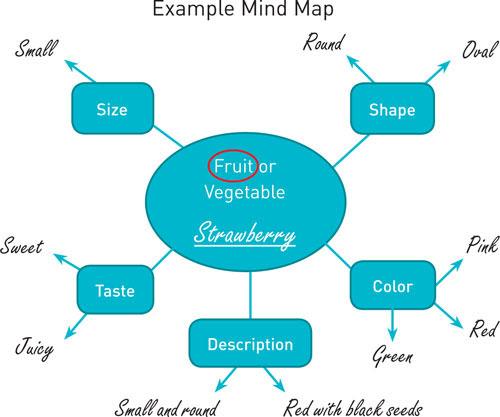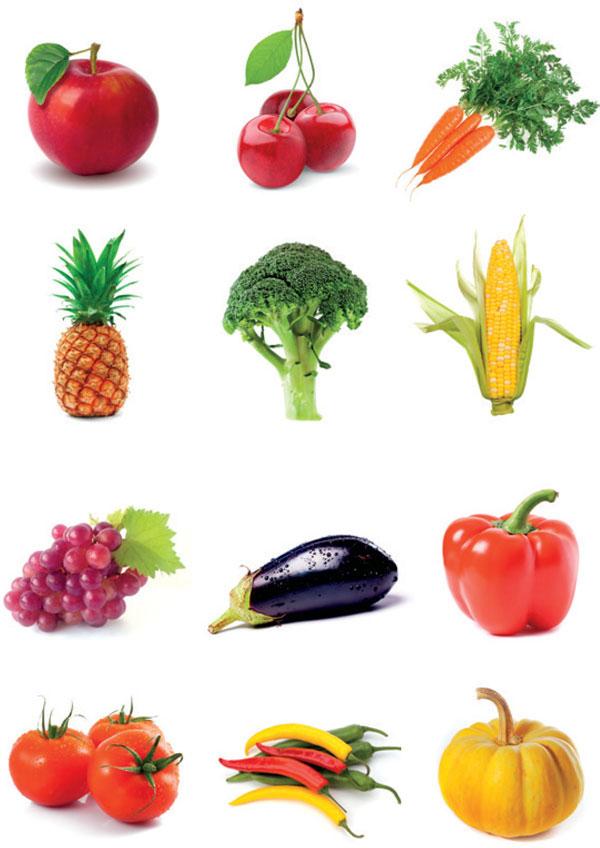Create To Communicate
LESSON 1
FOOD
Yummy, Yummy!
Objectives: Students will ask questions and respond with answers in a food guessing game and will use descriptive adjectives in an information gap drawing activity.
Level: Beginner to Low Intermediate
Materials: Sculpting dough (various colors if possible), pencils, paper, and tape. Optional: markers, crayons, colored pencils, or images or samples of fruits and vegetables.
Teacher Preparation: 1. Photocopy the fruit and vegetable images on page 77. Cut each fruit or vegetable picture out and tape it to a note card. Another option is to find your own fruit and vegetable images to use, or draw fruits and vegetables on note cards. Each note card should have only one fruit or vegetable on it. Make sure there are enough cards for every student in your class. 2. If possible, make sculpting dough for students to use in this activity. Sculpting dough recipes are included in Appendix C. (If materials for sculpting dough are not available, students can complete this activity as a drawing activity.) 3. If possible, duplicate the mind map template in the Reproducible Worksheet section. 4. Prepare the signs for the human graph activity in Part Four.
Art Options: If sculpting dough is not available, this activity can be completed as a drawing or painting activity. Students can draw a fruit or vegetable with pencils, crayons, markers, or colored pencils. If tempera or watercolor paints are available, students can make a fruit or vegetable painting.
INSTRUCTIONS
Part One: Fruit and Vegetable Warm-Up Activity
- Make fruit or vegetable cards before playing this game. See the instructions in the Teacher Preparation section.
- Depending on the level of your students, review the names of the fruits and vegetables, adjectives that might describe the fruits or vegetables, and the words for colors, shapes, or sizes of the fruits and vegetables.
- Mix the cards up and tape one fruit or vegetable card on the back of each student.
- Tell students that when you say “Go!” they must walk around the classroom and find a partner. The pair should then ask yes/no questions to try to figure out which fruit or vegetable is taped on their backs. Possible yes/no questions may include the following:
Is it a vegetable? Is it bitter? Is it sweet? Do you eat the vegetable (or fruit) with a fork? Is it salty? Do you eat it with a spoon? Is it red? Does it grow in the ground? Is it a small fruit (or vegetable)? Does it grow on a tree? Is it large? - When one student answers “no” to a question, it is the other student’s turn to ask questions about the fruit or vegetable card on his or her back. If both students get a “no” answer, the students must continue walking around the classroom to find different partners.
- Students should continue asking questions until they can figure out which fruit or vegetable is taped to their backs.
Part Two: Fruit and Vegetable Mind Maps and Sculptures
- Break students up into small groups.
- Use the fruits and vegetables note cards from the previous activity and assign a fruit or vegetable to each group. (If possible, bring in actual samples of different types of fruits and vegetables.)
- Tell each group they must brainstorm adjectives to describe their fruit or vegetable. Students can focus on describing its size, shape, color, and taste.
- Groups should create a mind map to record their brainstormed answers. Groups can use the mind map template included at the end of this section, or they can create their own.
- After the groups have finished filling out their mind maps, have them switch mind maps and fruit or vegetable cards with another group.
- The new group should add any additional descriptive adjectives they can think of to the mind map.
- If desired, repeat the activity and have groups fill out another mind map for a different fruit or vegetable.

- Tell students they will be creating a small sculpture of one of the fruits or vegetables they have described.
- Demonstrate to students how to create a food sculpture. For example, to create a strawberry, use red sculpting dough and form the dough into a small round shape. Next, you could take a small amount of green sculpting dough and roll it into a skinny rectangle to use for the stem. You could then flatten a piece of green dough to make a little leaf and attach it to the base of the stem. Lastly, you could use a pencil to poke holes into the strawberry to represent the seeds, or stick small pieces of sculpting dough to the strawberry for the seeds.
- Pass out sculpting dough to students and have them begin working.
- Tell students to refer to their mind maps or fruit and vegetable cards if needed.
Part Three: Information Gap Drawing Activity
- To further reinforce descriptive adjectives, do an information gap drawing activity with students:
a. When students are finished with their sculptures, ask them to place their sculptures on one central desk or table.b. Tell students to find a partner. One person in the pair should be the describer, while the other person is the drawer.c. The describer should pick one fruit or vegetable sculpture from the central desk and bring it to his or her desk, without showing it to his or her partner.d. The describer should then begin describing the fruit or vegetable sculpture to his or her partner. The partner should draw what he or she hears. Remind the describer to explain the primary shapes of the item first and the small details of the item last.e. If crayons, colored pencils, or markers are available, the describers can also use color in their descriptions.f. When they are finished, students can compare their drawings to the sculptures.g. Have partners switch roles and choose a new fruit or vegetable sculpture to describe.
Part Four: Human Graph Closing Activity
- To poll which fruits and vegetables students prefer the most, have students make a human graph as a closing activity.
- Before starting the activity make five signs. The signs should say Love it, Like it, It’s okay, Don’t like it, and Hate it.
- Review what each sign means with students. Use gestures and facial expressions to demonstrate the meanings.
- Tape the signs in five different locations around the classroom.
- Tell students that when you hold up a fruit or vegetable sculpture they must walk to the sign that expresses how they feel about that fruit or vegetable: Love it, Like it, It’s okay, Don’t like it, and Hate it.
- When each student has chosen a sign, ask students under the different categories why they love, like, or hate that particular fruit or vegetable. Students should naturally use some of the previously brainstormed descriptive adjectives. For example, “I love strawberries because they are sweet and juicy.”
- Keep repeating the activity by holding up a new fruit or vegetable sculpture. Students must move again to the sign that best describes how they feel about that item. Again, keep asking different students about their feelings.
- For each fruit or vegetable sculpture that is held up, count how many students are standing under each category. Students can then make graphs that show which fruits or vegetables the class likes the best and least.
Extension Activity:
Alphabet Food Poem
Have students write an alphabet poem about fruits, vegetables, or other foods. An alphabet poem follows the order of the alphabet, listing a word or phrase that begins with the corresponding letter. Alphabet poems can be simple and can be used with beginning learners to reinforce vocabulary and the alphabet, or they can be made more difficult for intermediate learners by instructing students to list adjectives that describe food. See the examples below. Students can work in pairs, groups, or together as a class to complete the poem.
Using Foods
Apple
Banana
Carrot
Dates
Eggplant
Fish
Garlic
Hamburger
etc.
Banana
Carrot
Dates
Eggplant
Fish
Garlic
Hamburger
etc.
Using Food Adjectives
Aromatic, acidic, appetizing
Buttery
Crunchy, crispy, creamy
Delicious, dry
Edible
Fragrant, flavorful, fruity
Good
Hot
etc.
Buttery
Crunchy, crispy, creamy
Delicious, dry
Edible
Fragrant, flavorful, fruity
Good
Hot
etc.
Internet Resources:
Fruit and Vegetable Word Search
Create a word search with the fruit and vegetable vocabulary used in this activity. Word searches are a fun way to reinforce vocabulary words and their spellings. You can easily create word searches on the website below.
Discovery Education Puzzle Maker: www.discoveryeducation.com/puzzlemaker/
Learn About Healthy Eating!
Visit the U.S. Government’s Food Plate website for information, activities, multimedia and more on healthy eating. http://www.choosemyplate.gov
EAT YOUR FRUITS AND VEGETABLES!

MIND MAP
Directions: Describe your fruit or vegetable using the mind map below.
